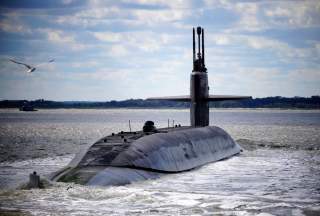 Key point: Nuclear missile submarines help deter America's rivals. In order to keep these submarines hidden and safe, the Navy is aiming to make them even quieter.
Key point: Nuclear missile submarines help deter America's rivals. In order to keep these submarines hidden and safe, the Navy is aiming to make them even quieter.
The Navy has now issued at least one-fourth of the design work and begun further advancing work on systems such as a stealthy "electric drive" propulsion system for the emerging nuclear-armed Columbia-Class ballistic missile submarines by 2021.
“Of the required design disclosures (drawings), 26-percent have been issued, and the program is on a path to have 83-percent issued by construction start,” Bill Couch, spokesman for Naval Sea Systems Command, told Warrior Maven.
The Columbia class is to be equipped with an electric-drive propulsion train, as opposed to the mechanical-drive propulsion train used on other Navy submarines.
In today’s Ohio-class submarines, a reactor plant generates heat which creates steam, Navy officials explained. The steam then turns turbines which produce electricity and also propel the ship forward through “reduction gears” which are able to translate the high-speed energy from a turbine into the shaft RPMs needed to move a boat propeller.
“The electric-drive system is expected to be quieter (i.e., stealthier) than a mechanical-drive system,” a Congressional Research Service report on Columbia-Class submarines from earlier this year states.
Designed to be 560-feet– long and house 16 Trident II D5 missiles fired from 44-foot-long missile tubes, Columbia-Class submarines will use a quieting X-shaped stern configuration.
The “X”-shaped stern will restore maneuverability to submarines; as submarine designs progressed from using a propeller to using a propulsor to improve quieting, submarines lost some surface maneuverability, Navy officials explained.
Navy developers explain that electric-drive propulsion technology still relies on a nuclear reactor to generate heat and create steam to power turbines. However, the electricity produced is transferred to an electric motor rather than so-called reduction gears to spin the boat's propellers.
The use of an electric motor brings other advantages as well, according to an MIT essay written years ago when electric drive was being evaluated for submarine propulsion.
Using an electric motor optimizes use of installed reactor power in a more efficient way compared with mechanical drive submarines, making more on-board power available for other uses, according to an essay called “Evaluation and Comparison of Electric Propulsion Motors for Submarines." Author Joel Harbour says that on mechanical drive submarine, 80-percent of the total reactor power is used exclusively for propulsion.
“With an electric drive submarine, the installed reactor power of the submarine is first converted into electrical power and then delivered to an electric propulsion motor. The now available electrical potential not being used for propulsion could easily be tapped into for other uses,” he writes.
Research, science and technology work and initial missile tube construction on Columbia-Class submarines has been underway for several years. One key exercise, called tube-and-hull forging, involves building four-packs of missile tubes to assess welding and construction methods. These structures are intended to load into the boat’s modules as construction advances.
“Early procurement of missile tubes and prototyping of the first assembly of four missile tubes are supporting the proving out of production planning,” Couch said.
While the Columbia-Class is intended to replace the existing fleet of Ohio-Class ballistic missile submarines, the new boats include a number of not-yet-seen technologies as well as different configurations when compared with the Ohio-Class. The Columbia-Class will have 16 launch tubes rather than the 24 tubes current on Ohio boats, yet the Columbias will also be about 2-tons larger, according to Navy information.
The Columbia-Class, to be operational by the 2028, is a new generation of technically advanced submarines intended to quietly patrol the undersea realm around the world to ensure second-strike ability should the US be hit with a catastrophic nuclear attack.
Formal production is scheduled for 2021 as a key step toward fielding of a new generation of nuclear-armed submarines to serve all the way into and beyond the 2080s.
General Dynamics Electric Boat has begun acquiring long-lead items in anticipation of beginning construction; the process involves acquiring metals, electronics, sonar arrays and other key components necessary to build the submarines.
Both the Pentagon and the Navy are approaching this program with a sense of urgency, given the escalation of the current global threat environment. Many senior DoD officials have called the Columbia-Class program as a number one priority across all the services.
“The Columbia-Class submarine program is leveraging enhanced acquisition authorities provided by Congress such as advanced procurement, advanced construction and multi-year continuous production of missile tubes,” Couch added.
Kris Osborn, Managing Editor of Warrior Maven can be reached at krisosborn.ko@gmail.com. This first appeared here.
This article first appeared in 2018.
No comments:
Post a Comment